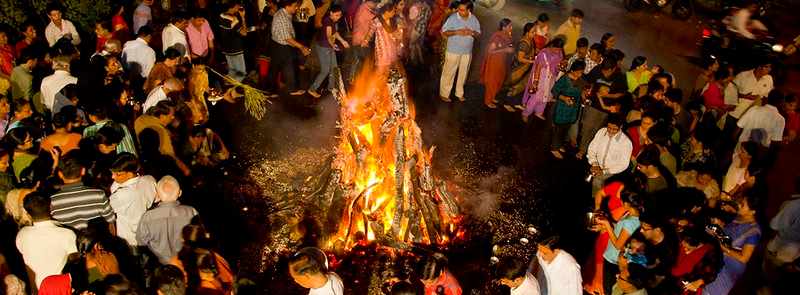
When It Occurs
Annually Night Before Holi
Timeline
Days Passed (982)
# Hashtags
#HolikaDahana #HolikaDeepak
Holika Dahan, also known as Holika Deepak or Choti Holi, is a Hindu festival that observes the ceremonial burning of the demoness Holika. Annually celebrated in March, the specific date is determined by the Indian lunar calendar. This symbolic ritual signifies the triumph of good over evil and serves as a precursor to the festival of Holi, which joyfully heralds the arrival of the spring season.
Mythological Background:
Holika Dahana is closely associated with the story of Hiranyakashipu, Prahlad, and Holika from the Bhagavata Purana. According to Hindu mythology:
-
Hiranyakashipu was a powerful demon king who wanted to be worshiped as a god. He believed that his devotion to Lord Brahma had made him invincible, and he sought to conquer the world and challenge the gods.
-
However, Hiranyakashipu’s son, Prahlad, was a devout follower of Lord Vishnu. This infuriated Hiranyakashipu, who saw his son's devotion to Vishnu as a betrayal. He tried multiple times to kill Prahlad, but each attempt failed due to Vishnu’s protection.
-
In his final attempt, Hiranyakashipu enlisted the help of his sister, Holika, who had a boon that made her immune to fire. She planned to sit with Prahlad on her lap in a blazing fire, hoping that the fire would consume him but leave her unharmed. However, Holika’s boon only worked when she entered fire alone. With Vishnu’s blessing, Prahlad emerged unharmed, while Holika was burned to ashes.
-
This event signifies the triumph of good (Prahlad's devotion) over evil (Holika and Hiranyakashipu’s arrogance), and thus, the burning of Holika became a symbol of the destruction of evil.
Significance of Holika Dahana:
-
Victory of Good over Evil: The bonfire represents the destruction of negative forces in life, such as ego, anger, and hatred, similar to how Prahlad's faith overcame the evil plans of his father and aunt.
-
Celebration of Devotion: Prahlad’s unwavering devotion to Lord Vishnu is a reminder of the power of faith and belief in righteousness.
-
Welcoming Spring: Holika Dahana also marks the end of winter and the beginning of spring. The ritual of lighting bonfires is thought to cleanse the atmosphere and prepare for the vibrancy of Holi, the festival of colors, which follows the next day.
Rituals and Customs of Holika Dahana:
-
Preparations for the Bonfire:
- In the days leading up to Holika Dahana, people gather wood, sticks, and other combustible materials to build large pyres in community spaces, temples, or courtyards.
- An effigy of Holika, often made of straw or wood, is placed on top of the pyre to symbolize the demoness.
-
Bonfire Ceremony:
- On the night of Holika Dahana, which typically falls on the full moon (Purnima) of the Hindu month of Phalguna (February or March), the pyre is lit after sunset.
- People gather around the bonfire, sing songs, chant prayers, and perform puja (worship) to honor the gods and seek blessings for prosperity and protection from evil.
- Many offer grains, coconuts, and other items to the fire as a symbol of thanksgiving and purification.
-
Circling the Fire (Parikrama):
- It is customary for devotees to walk around the fire (usually three or seven times) while offering prayers for the well-being of their family.
- Some also take ashes from the fire to smear on their foreheads, as the ashes are believed to bring blessings and protection.
-
Traditional Foods:
- People often prepare special dishes and sweets during Holika Dahana, such as gujiya, puran poli, dahi vada, and thandai (a spiced milk drink).
Regional Variations of Holika Dahana:
Holika Dahana is celebrated with slight variations across different regions of India:
-
In Uttar Pradesh and Bihar, the bonfire is central to the community celebration, with large crowds gathering to witness the burning of Holika.
-
In Gujarat, the celebration begins with a grand puja and the offering of coconuts to the fire, symbolizing the wish for good harvests and prosperity.
-
In Punjab, Holika Dahana is celebrated with great enthusiasm, particularly in rural areas, where villagers light large fires and dance around them.
-
In Maharashtra and Goa, the festival is called Shimgotsav, and it involves traditional dances and folk music as part of the Holika Dahana celebration.
-
In West Bengal, Holika Dahana is referred to as Dol Purnima, where the festival is integrated with the worship of Lord Krishna and Radha. The bonfire is less prominent, and the focus shifts to colorful processions and the celebration of love and devotion.
Importance in the Holi Festival:
Holika Dahana is essentially the prelude to Holi, the vibrant festival of colors celebrated the next day. While Holika Dahana is more spiritual and symbolic, Holi is a joyous, playful festival where people throw colored powders, splash water, and celebrate love and unity. The destruction of Holika is a metaphor for overcoming darkness and paving the way for a bright, colorful, and joyful future, symbolized by Holi.
Environmental Concerns:
In recent years, environmentalists have raised concerns about the use of excessive wood and pollution caused by the large bonfires. As a result, eco-friendly practices are being promoted in various parts of India. These include using waste materials for the bonfire, reducing the size of the pyre, and planting trees after the celebration to offset the environmental impact.
Conclusion:
Holika Dahana is a festival deeply embedded in Indian culture and Hindu traditions. It serves as a reminder of the power of devotion, faith, and the ultimate triumph of good over evil. Celebrated with bonfires, prayers, and joyous gatherings, it heralds the arrival of spring and sets the stage for the exuberant celebration of Holi, spreading messages of harmony, unity, and new beginnings.


